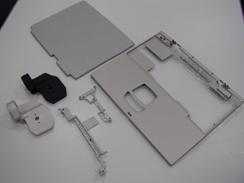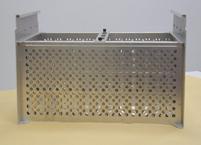
Scope of application-Surface Treatment Process for Magnesium Alloys
 The trend of metal consumption is moving from traditional heavyweight metals like bronze, steel and iron to the light weight with high strength metals like titanium, aluminum, and magnesium. Especially for the packaging of computer, communication, and consumer related electronic products(3C), light weight become a must. One more requirement for using light weight metal as the packaging of electronic products is to improve the EMI shielding by the high electric conductivity and grounding of metal. Especially for magnesium alloy, the inherent lightness and good strength-to-weight ratio has attracted more attention. Its density is two thirds that of aluminum(1.74), and it provides the best specific damping capacity of all metals. Therefore, it becomes the best candidate for many mobile electronic products such as notebook computer, cellular phone, and camcorder.
The trend of metal consumption is moving from traditional heavyweight metals like bronze, steel and iron to the light weight with high strength metals like titanium, aluminum, and magnesium. Especially for the packaging of computer, communication, and consumer related electronic products(3C), light weight become a must. One more requirement for using light weight metal as the packaging of electronic products is to improve the EMI shielding by the high electric conductivity and grounding of metal. Especially for magnesium alloy, the inherent lightness and good strength-to-weight ratio has attracted more attention. Its density is two thirds that of aluminum(1.74), and it provides the best specific damping capacity of all metals. Therefore, it becomes the best candidate for many mobile electronic products such as notebook computer, cellular phone, and camcorder.
Although magnesium has so many advantages, it has a major drawback: it is prone to atmospheric corrosion. Furthermore, because of its high chemical affinity for aqueous solutions, it is difficult for electrochemical treatment. The situation is more complicate for the magnesium alloys, where the alloying constituents introduce electrochemical heterogeneity.
For most of the metal alloys, atmospheric corrosion is the major factor that degrades the metal performance and life. Therefore, certain surface treatments to improve corrosion resistance and paint adhesion are necessary, which include anodizing and chromate conversion coating to create a porous metal oxide layer. These metal surface treatment processes has been used for years and showed excellent performance. However, the complexity of processes and the toxicity of the process chemicals always gather lots of concern, but the major concern is on the environmental impacts that created by the process. The acids and chromate cause the large amount wastewater streams generated by these processes to be a serious environmental problem, and the hexavalent chromium ions containing solid waste is increasingly difficult and costly to dispose off. EPA of United states and Health Agency of United Nation all restrict the usage of chromate containing chemicals, and plan to totally eliminate them in a few years. In 1998, EPA of Taiwan has also raised the standard of wastewater stream of hexavalent chromium ion concentration to less than 0.5ppm, and also need to report for every usage of chromate containing chemicals.
Magnesium alloy die-casing parts, AZ91D for example, need to do the surface treatment right after die casting to slow down the atmospheric corrosion and improve the paint adhesion. Traditional surface treatment processes for magnesium alloys are chromate conversion coating or chromate chemicals related anodizing processes. Many of them came with serial number from Dow Chemical Co., such as Dow 17 and Dow 20. In these processes, many toxic and high pollution chemicals like chromate, chromic acid, hydrofluoric acid, and nitric acid are used. In the process, large amount of rinse water needs to be used after chromating process. It is not only the concern of large consumption of water, but also creates serious pollution of wastewater stream and solid waste with hexavalent chromium ion. Besides these problems, there are many other disadvantages as following:
|
1.
|
Large amount of wastewater and pollution increase the investment and cost of the magnesium alloys surface treatment significantly.
|
|
2.
|
It is difficult to control the concentration of chromate chemicals, which will lead to the unstable of quality.
|
|
3.
|
In order to etch the metal surface for producing porous oxide, the dimension of the casting parts will be etch out for a significant amount and change the precision.
|
|
4.
|
The magnesium alloys after treatment show dark brown surface with non-uniform color, the metallic appearance will be totally disappeared.
|
|
5.
|
Chromate chemicals are restricted and need to be controlled, managed, and reported to EPA periodically. It is a significant load for management and manpower cost.
|
|
6.
|
One thing that has not been paid enough attention is the significant amount of chromate chemicals is still remained on the magnesium surface. If no topcoat to isolate these toxic chemicals, diffusion of these hazardous compounds may cause secondary pollution, especially for the users.
|
For most of the computer and information related high-tech industries, Environmentally benign process is one of the requirements, which is also one of the requirements of ISO14000. Therefore, searching for a non-chromate, environmentally friendly process for surface treatment of magnesium alloys has been ongoing for a certain time. However, up to now no any promising process has been established.
 |
 |

